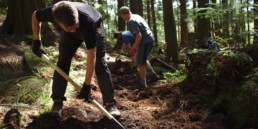A trail of one's own?
Separate Trails Divide; Shared Trails Unite
by Jim Hasenauer, IMBA Past President
IMBA activists have often heard proposals for separate mountain bike trails. The idea seems to appeal to a number of people because it purports to eliminate user conflict with other trail goers. Bicyclists confronted with the choice between separate trails or total closure have sometimes accepted a separate trail solution.
I think mountain bicyclists should think carefully before endorsing this idea. It perpetuates the myth that bicycling is incompatible with other uses. It threatens access to existing multiple use trail systems. Often, it unnecessarily leads to the too many trails in an ecosystem best left wild.
Sometimes, the pressure for separate trails comes from other users who don’t want bicyclists on “their trails”. They may be hikers who feel their sweat equity has given them ownership, or motorcyclists whose green sticker money has actually paid for trail opportunities. Hoarding the thousands of miles of existing trails, some users have told bicyclists to go build their own. This country club mentality has no place on the public lands and while bicyclists are willing to build and maintain trails, it makes sense for us to do it with and for the benefit of all trail users.
Some land managers think separate trails will eliminate user conflict. It’s commonplace in recreational land management to separate incompatible uses. This philosophy need not apply. Responsible bicycle use is compatible in most cases. When users know that a trail is multiple use, they expect to encounter others. When users follow trail protocol, they can safely negotiate their trail encounters. Besides being unnecessary, monitoring and enforcing separate trails is a management nightmare.
Even if bicyclists and other users had separate but equal mileage (something I’ve never seen proposed), they’d covet their neighbors’ trails. Everyone would still want to see what the other users were enjoying. Trail users like to explore. Twenty miles of multiple use trail is worth more than two separate ten mile sections.
From day one, IMBA has advocated multiple-use trails. This position is based on the following beliefs:
- Shared use trails can best accommodate the needs of the most users. A generally open backcountry disperses users across an entire trail system. Single use or restricted use trails tend to concentrate users. This increases social impacts through crowding.
- Sharing trails help build a trail community by increasing the need for all users to cooperate to preserve and protect a common resource. Encountering other users on a trail offers the opportunity to meet and talk. Without that opportunity, it’s difficult to establish mutual respect and courtesy. Separate trails breed ill will, territoriality and rivalries.
- Shared trails are most cost effective for land managers. They require fewer signs and less staff. Monitoring and enforcement is simplified.
- Shared trails enable responsible, experienced users to educate outlaws and novices. Because they share the same trail system, the opportunity for peer regulation is enhanced.
- Single-user trails increase demands for the construction of additional trails to serve other single user groups. This increases the ecosystem impacts including potential habitat fragmentation and water sedimentation. IMBA is aware that local conditions vary and that sometimes separate trails are a legitimate compromise solution to a management problem. There are a couple of cases where separate trails make good sense. Large trail systems with very crowded trailheads could have separate feeders. A designated mountain bike area could allow experts to race train without the inconvenience of other users. Some very technical, trials type sections might be set aside for mountain bikers to hone their skills. Similarly, trails designated for mountain bike beginners might allow for individuals to develop their trail riding abilities before joining other users on the multiple use trail systems. It’s hard to think of many other situations where separate trails offer any advantages.



